List of National Historic Landmarks in Utah
This is a complete List of National Historic Landmarks in Utah. The United States National Historic Landmark program is operated under the auspices of the National Park Service, and recognizes structures, districts, objects, and similar resources according to a list of criteria of national significance.[1] The state of Utah is home to 14 of these landmarks, tying together a wide range of historic threads.
The table below lists all 14 of these sites, along with added detail and description.
| [2] | Landmark name | Image | Date designated[3] | Location | County | Description |
|---|---|---|---|---|---|---|
| 1 | Alkali Ridge | 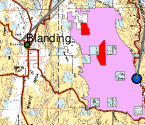 |
(#66000740) |
near Blanding Coordinates missing |
San Juan | A set of widely-scattered archaeological remains of the earliest forms of Puebloan architecture, representing a period of transition from scattered, pit-style dwellings to a settled agricultural lifestyle. These multi-story buildings and kivas have yielded high-quality ceramics, and form the type location for the Pueblo II period (c. 10th century - c. 11th century). Landmark area is shown in red on map. |
| 2 | Bingham Canyon Open Pit Copper Mine | 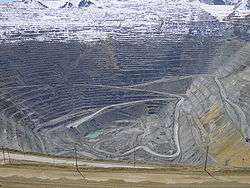 |
(#66000736) |
Oquirrh Mountains 40°31′20″N 112°08′58″W / 40.52236°N 112.14947°W |
Salt Lake | The world's first and largest open-pit copper mine, Bingham Canyon was opened in 1904. |
| 3 | Bryce Canyon Lodge and Deluxe Cabins |  |
(#87001339) |
Bryce Canyon National Park 37°37′34″N 112°10′00″W / 37.62618°N 112.16656°W |
Garfield | The Union Pacific Railroad built this national park lodge in 1924-1927. The architectural style was used by railroads for lodges across the American west with the encouragement of the National Park Service. |
| 4 | Central Utah Relocation Center (Topaz) | 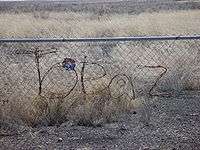 |
(#07000432) |
near Delta 39°24′40″N 112°46′20″W / 39.411111°N 112.772222°W |
Millard | One of 10 relocation centers for internment of Japanese Americans during World War II. The internees were mostly from northern California and the San Francisco Bay Area, and included many professional artists.[4] |
| 5 | Danger Cave | 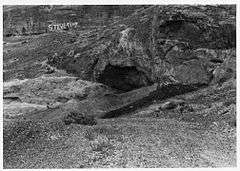 |
(#66000741) |
near Wendover 40°45′07″N 114°00′57″W / 40.751944°N 114.015833°W |
Tooele | |
| 6 | Desolation Canyon | |
(#68000057) |
on the Green River 39°25′00″N 110°00′40″W / 39.416667°N 110.011111°W |
Carbon, Emery, Grand, and Uintah | This remote canyon on the Green River was traversed by John Wesley Powell in 1869. Powell's expedition was sponsored by the Smithsonian Institution. |
| 7 | Emigration Canyon |  |
(#66000737) |
Salt Lake City 40°46′00″N 111°46′00″W / 40.766667°N 111.766667°W |
Salt Lake | The Mormon pioneers traversed the Wasatch Range through this canyon at the western end of their trail, beginning in 1847. The canyon mouth is the location of Brigham Young's famous quotation "This is the place." |
| 8 | Fort Douglas | 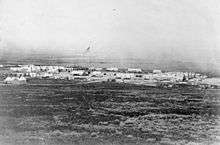 |
(#70000628) |
Salt Lake City 40°45′53″N 111°50′01″W / 40.76467°N 111.8337°W |
Salt Lake | This US Army post was established in the 1860s to uphold United States authority in the Mormon territories, and to protect overland transportation and communication lines. |
| 9 | Mountain Meadows Massacre Site |  |
(#11000562) |
Central 37°28′32″N 113°38′37″W / 37.475481°N 113.643625°W |
Washington | Site of the controversial 1857 massacre of migrants by Utah territorial militia. |
| 10 | Old City Hall |  |
(#71000846) |
Salt Lake City 40°46′26″N 111°53′12″W / 40.77393°N 111.8868°W |
Salt Lake | Completed in 1866, the city hall also served as the capitol of the Utah Territory, and was the scene of many tensions between Mormon leaders and the United States. |
| 11 | Quarry Visitor Center |  |
(#86003401) |
Dinosaur National Monument 40°26′25″N 109°18′05″W / 40.4404°N 109.30125°W |
Uintah | Built as part of the National Park Service's Mission 66 program of modern architectural design in the US national parks, this visitor center exemplifies the philosophy of locating visitor facilities immediately at the resource being interpreted. The building was closed due to structural damage from unstable soils in 2006, and extensive works, including construction of a new visitor center, were undertaken. |
| 12 | Reed O. Smoot House | 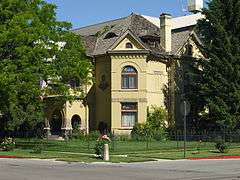 |
(#75001831) |
Provo 40°13′56″N 111°39′20″W / 40.232339°N 111.655529°W |
Utah | The home of Reed Smoot from 1892 to his death in 1941. Smoot was a prominent US Senator best known for advocacy of protectionism and the Hawley-Smoot Tariff. |
| 13 | Temple Square | 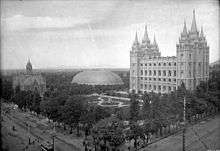 |
(#66000738) |
Salt Lake City 40°46′12″N 111°53′34″W / 40.770083°N 111.89267°W |
Salt Lake | The earthly center of The Church of Jesus Christ of Latter-day Saints. Begun in the mid-19th century, the Square's Mormon landmarks include the Salt Lake Temple, the Tabernacle, and the Assembly Hall. |
| 14 | Brigham Young Complex |  |
(#70000626) |
Salt Lake City 40°46′04″N 111°53′17″W / 40.76771°N 111.88795°W |
Salt Lake | The Beehive House and adjacent Lion House were the residence of Brigham Young from 1852 until his death in 1877. As President of The Church of Jesus Christ of Latter-day Saints at the time of the Mormon settlement of the Salt Lake Valley, Young and his home were pivotal in the development of the Church, Utah, and the American west. |
See also
References
- ↑ National Park Service. "National Historic Landmarks Program: Questions and Answers". Retrieved 2007-09-21.
- ↑ Numbers represent an ordering by significant words. Various colorings, defined here, differentiate National Historic Landmarks and historic districts from other NRHP buildings, structures, sites or objects.
- ↑ The eight-digit number below each date is the number assigned to each location in the National Register Information System database, which can be viewed by clicking the number.
- ↑ "Interior Secretary Kempthorne Designates 12 National Historic Landmarks in 10 States" (Press release). U.S. Department of the Interior. 2007-04-04. Retrieved 2007-05-29.
External links
![]() Media related to National Historic Landmarks in Utah at Wikimedia Commons
Media related to National Historic Landmarks in Utah at Wikimedia Commons
- National Historic Landmark Program at the National Park Service
- Lists of National Historic Landmarks
This article is issued from Wikipedia - version of the 11/21/2016. The text is available under the Creative Commons Attribution/Share Alike but additional terms may apply for the media files.